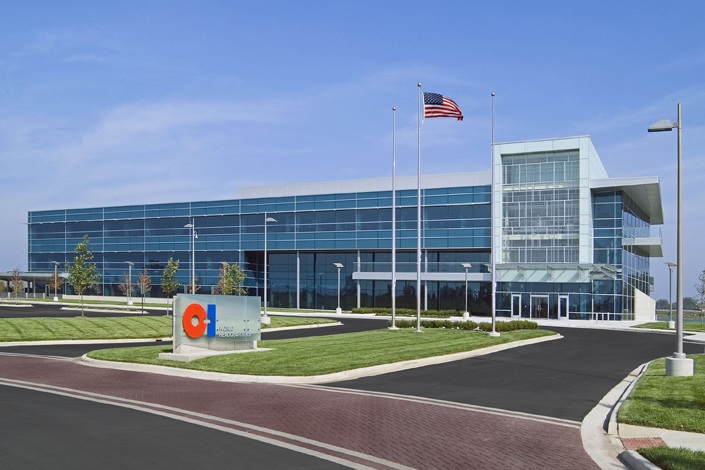Date: 6 April 2005
CLARION - It began almost 100 years ago, but didnt start off making what it is making now. And in the process of becoming Clarion County s most long-lived manufacturing enterprise, it burned to the ground twice.
What is now the Owens-Illinois glass plant got off to a rough start, says Russ Hoenig, mold repair supervisor and unofficial historian at Owens-Brockway Glass Containers, popularly and simply known in Clarion as the glass plant.
Hoenig spoke at a recent Clarion Community Breakfast sponsored by Clarion University and held at the American Legion banquet room along Main Street .
Clarion University Relations Director Ron Wilshire said it was the largest attendance yet seen at the community breakfasts. The crowd included large numbers of current and former Owens employees.
C.F. Heidrick and Pearl Glass
The idea of a factory to make glass in Clarion began in Brookville, Hoenig said.
C.F. Heidrick owned woolen mills in Brookville, across the intersection from the Brookville Glass Company. Heidrick would watch from his office as the Brookville Glass shipped raw materials in and finished products out.
Heidrick knew community leaders in Clarion were trying to get a railroad from the east side of Clarion to Summerville and such transportation infrastructure would make a glass factory possible in Clarion.
So Heidrick met with community leaders and proposed a glass plant in Clarion. Some other businessmen had the same idea, and in 1905, the announcement was made that two glass factories would be built in Clarion Heidricks enterprise and the Clarion Glass Company.
While Clarion Glass Company was never heard of again (the plans were for a plant where the Clarion University student activities center is now), Heidrick opened the Pearl Glass Company (apparently named after the daughter of the Clarion County sheriff) the next year to make pressed glass tableware.
On March 11, 1906 , Pearl Glass made its first piece a pressed glass dessert bowl presented to Alta Kahle. Tests continued for several days until the pressing machine broke down, forcing a fortune ($2,000 in 1906 dollars) in glass to be drained from the furnace.
The plant restarted May 24, 1906 , but a week later another manufacturing disaster: the plants compressor engines were started, but someone forgot to turn on the cooling water. The engines overheated and were badly damaged, and the plant did not restart until August.
And when it did, it was owned by a group of Clarion businessmen and backed by the Second National Bank, and it had doubled in size and capacity, with a second furnace in a second building. The plant now made glass bottles instead of tableware and the company was advertising for workers.
Pearl Glass was soon making 3,600 bottles a day quite a number in those days with its two furnaces.
Disasters of fire and finance
Disaster struck again in 1908 when the wooden buildings of the plant, dried out from the heat of glassmaking, burned to the ground.
In those days, glass making was much simpler and hand tools predominated, and the plant was rebuilt and restarted in six weeks.
The plant operated well for a few years, and a 1911 newspaper article praised the enterprise and stated it was doing very well. But in 1912 the plant was belly up, Hoenig said. It wasnt clear why, but a bank failure could have been an underlying reason.
The plant was put up for sheriffs sale in August of 1912, and a syndicate of local businessmen led by M.M. Kaufman and F.G. Keatley bought the facility.
Their intent was to get the plant back in operation, and the syndicate quickly sold it to the Berney-Bond Glass Company of Bradford for the same price they paid at sheriffs sale. Berney-Bond had to agree that if it did not reopen the plant it would sell it back to the syndicate for the same price again.
The Berney-Bond years
Berney-Bond not only reopened the plant, it installed automatic machinery to bump production up to 4,800 units a day. The plant now specialized in making milk bottles to the extent that Clarion began calling itself the milk bottle capital of the world.
In 1920 fire struck again, burning the powerhouse and molding machines. It took six weeks to rebuild.
And in 1922, another fire swept the plant, this time destroying everything. Hoenig said pictures of the aftermath showed just a few walls standing. The offices and the records inside were wiped out and this has made it difficult to research the early history of the plant, Hoenig said.
Prohibition, depression & war
In 1929, then Owens Bottle Company bought the Illinois Glass Company, and the next year Owens-Illinois bought Berney-Bond. Owens was buying many small glass container companies in anticipation of the end of Prohibition and a renewed market for beer and liquor bottles.
Prohibition ended in 1933, but the Great Depression was underway, and there were people living in boxes and huts along Grand Avenue , waiting for jobs to open up at the glass plant.
But the plant thrived, and in 1935, Owens built the O-I Clubhouse for its employees and the community. Today, the clubhouse is used occasionally for parties and banquets, but in those days it was the main social center for Clarion.
The clubhouse was used almost twenty-four-seven, Hoenig said, for meals, entertainment and socializing. There was always something going on and it was open to all, he said.
At the start of the 1940s there were more than 500 people, mostly all men, working at the plant. But when World War II erupted, 220 of those workers went into active service and the glass plant saw a large influx of women.
The plant had its own newspaper, The Clarion Conveyer, during this period, and the publication carried news of the plant, of the community and of the employees serving in the armed forces.
The copy of Clarion Conveyor of Jan. 6, 1945 , on display at the community breakfast, carried tragic news: Sgt. Robert A. Johnston of Sligo , who had worked in selecting, was missing in action in Germany ; and Paul H. Sloan Jr. of Clarion, who had worked in the mold repair shop, was missing in action in southern France .
But better news from France was also on the front page: Sgt. Paul E. Hindman won the Silver Star for gallantry.
Post war years
A few years after the war, the plant saw some bad years due to a development in the container industry: the introduction of waxed cardboard milk cartons caused the demand for glass milk bottles to drop precipitously, Hoenig said. Half of the plant shut down and many workers were laid off in 1948 through 1950.
But the plant found other markets and other kinds of containers; from the 1940s through the 1980s, Owens made almost all the glass containers for perfumes and cosmetics used by Avon .
The plant also made novelty containers some shaped like automobiles product lines that Hoenig said were unique, difficult and profitable.
Millions of bottles a day
While employment levels have dropped in recent decades to about 300 workers, the plants production is many times the 4,800 containers the plant made each day in the 1920s.
The plants machines can now produce 1,200 bottles a minute, for a total of 1.7 million units a day and 600 million each year.
The Owens plant at Clarion is medium sized, Hoenig said, and is considered a job change plant, meaning it is capable of making a wide range of different container types and styles. The plant has 175 different sets of molds available.
The future
While rumors and speculation regularly place the Clarion plant in its last days, as more and more containers are made of plastic rather than glass, the plant continues its high levels of quality production, and Hoenig says it should continue to do so well into the future.
The plant is here to make money, Hoenig said, and is measuring its progress continually in order to meet goals set by the Owens-Illinois headquarters in Toledo .
As long as we meet those goals, the future of the plant is in good hands at Clarion, Hoenig said.
The year 2006 will mark the 100th year of glass production in Clarion, and Hoenig said he will continue researching the history of the glass plant, and is considering publishing a book on the topic. He encouraged anyone with information articles, photos letters involving the history of the plant to get in touch with him.n



Add new comment